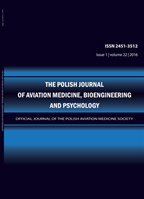2017, Volume 23, Issue 3-4
RECOLLECTION OF THE AVIATION PHYSIOLOGY LABORATORY AT MILITARY INSTITUTE OF AVIATION MEDICINE FROM THE PERSPECTIVE OF 50 YEARS OF PILOT PERFORMANCE RESEARCH
Bronisław TURSKI1
-------------------------------------------------------------------------------------------------
1-, -
Autor korenspondencyjny: Bronisław TURSKI; -, -; email: bronislaw.turski@wiml.waw.pl
Full text
Streszczenie
The author after graduating from the Medical Military Academy in 1965, he was sented for a postgraduate two-year internship in medicine at the Military Institute of Aviation Medicine (WIML), which he partly completed there and partly at the Second Central Clinical Hospital of the Medical Military Academy (WAM). After the internship he was sented to the Air Force Institute of Technology to work in the position of a senior physician of the infirmary. After less than two years in 1969 he was transferred to the position of an assistant professor to the Laboratory of Aviation Physiology at MIAM. The paper deals with the characteristics of scientific and application activities of the Laboratory of Aviation Physiology at WIML in the years 1969-1996. The subject of research was, among others, the assessment of physical performance and its impact on the effectiveness of the operation of pilots and cosmonauts in extreme conditions. The research was carried out with the use of many flight simulators, such as: thermo- and diving chamber, centrifuge, and also in laboratory conditions (e.g. stationary bikes) and in water (lakes) or mountain (Tatra Mountains) natural conditions. Moreover, the effects of vibrations on the functioning of helicopter pilots were also dealt with. As part of space medicine, a prototype of a vacuum capsule was created, the essential element of which was a “vacuum collar” (mounted around a pelvis of the tested person), enabling the capsule to be under-pressurized to the required level at the lower half of the body.
Słowa kluczowe
aeronautical and space physiology, body fitness, flight simulators
